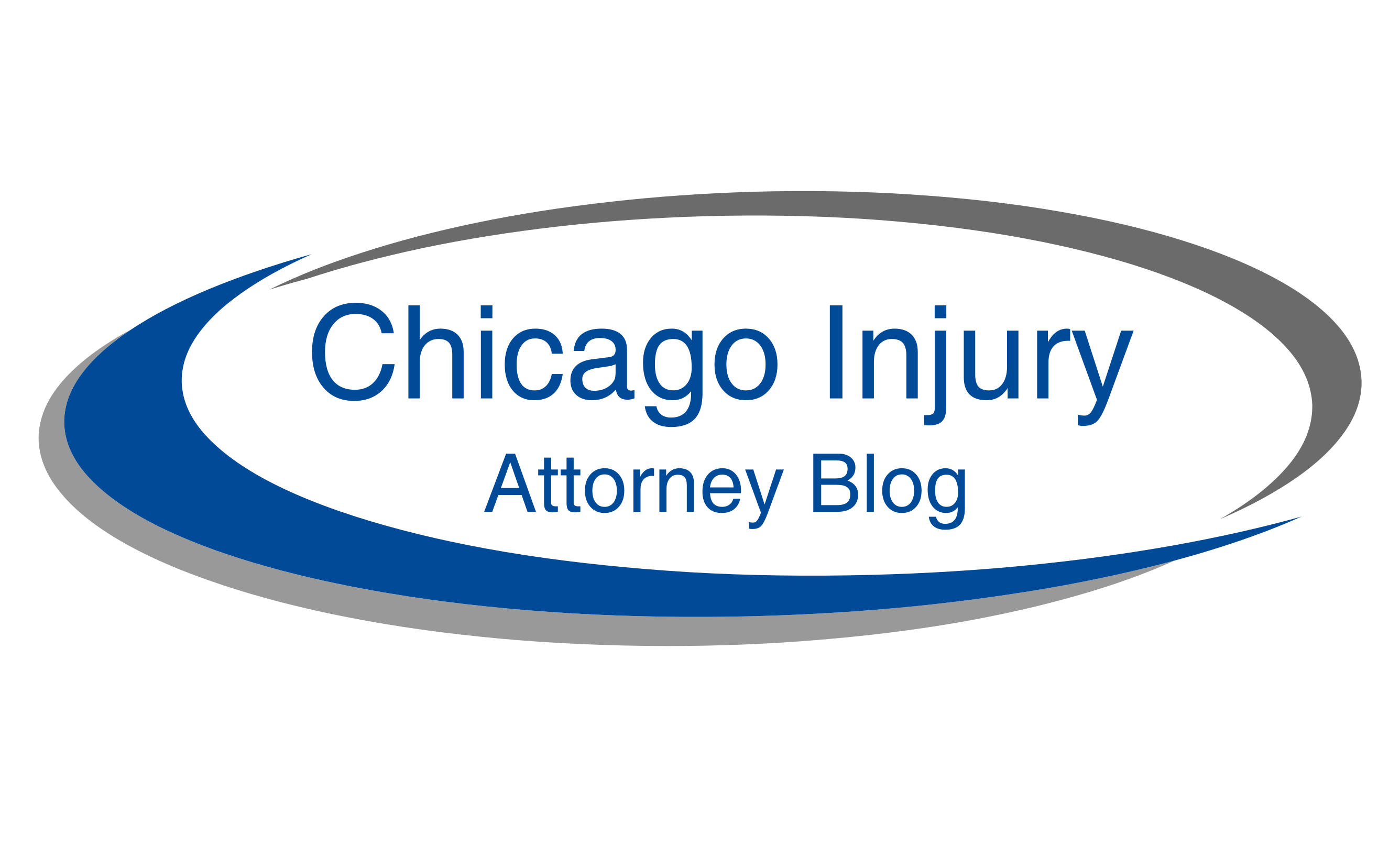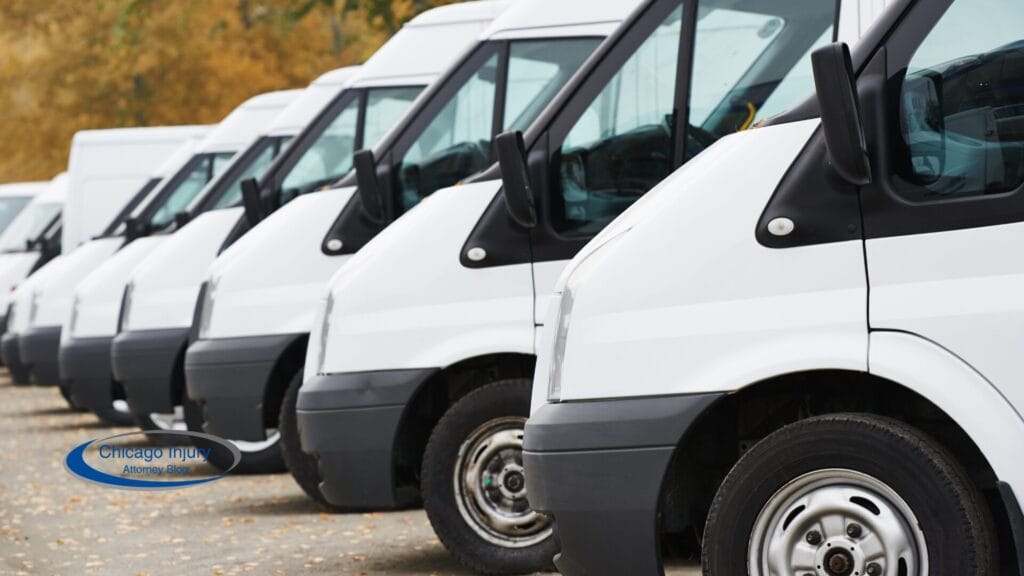In the vibrant urban landscape of Chicago and its surrounding areas, commercial vehicles serve an essential function in everyday life, facilitating the delivery of goods and the transportation of passengers.
A comprehensive understanding of what constitutes a commercial vehicle, along with its various categories—including semi-trucks, delivery vans, and buses—can assist in navigating the complexities associated with road safety.
This article will examine the common causes of commercial vehicle accidents, outline the legal requirements in Illinois, and detail the important steps to take if one is injured in such an incident.
By providing clarity on these critical topics, individuals can remain informed and empowered.
What Is A Commercial Vehicle?
A commercial vehicle, as delineated by federal regulations, refers to any motor vehicle utilized for business purposes, encompassing the transportation of passengers or cargo. These vehicles are subject to specific specifications and legal definitions that categorize them based on factors such as weight, design, and intended use.
In the United States, commercial motor vehicles (CMVs) must adhere to particular safety and maintenance standards to ensure compliance with both state and federal laws. This classification includes various types of vehicles, such as buses, trucks, and vans, all of which play a vital role in the economy by fulfilling commercial service and transportation needs.
What Are The Different Types Of Commercial Vehicles?
Commercial vehicles are available in a variety of types, each specifically engineered for distinct functions, including the transportation of goods and the conveyance of passengers. A comprehensive understanding of these diverse vehicle classifications is crucial for ensuring compliance with transportation laws and safety regulations.
Common classifications of commercial vehicles encompass:
- Semi-trucks
- Delivery trucks
- Buses
- Taxis
- Limousines
- Vans
- Tow trucks
Each type fulfills specific roles within the commercial sector, addressing a range of requirements such as cargo transport, passenger transport, and the handling of hazardous materials.
1. Semi-trucks
Semi-trucks, commonly referred to as tractor-trailers or articulated lorries, are a category of commercial vehicles specifically designed for the transportation of cargo. These vehicles are distinguished by their capacity to tow substantial trailers and are governed by stringent federal regulations concerning gross vehicle weight and safety standards. In the United States, semi-trucks play a pivotal role in the logistics and transportation sector, facilitating the efficient movement of goods over extensive distances.
These substantial vehicles are typically equipped with powerful diesel engines, often exceeding 300 horsepower, which enables them to haul heavy loads while striking a balance between performance and fuel efficiency.
A comprehensive understanding of specific operational requirements, including weight distribution and trailer compliance, is essential for ensuring safe travel on highways. Compliance with federal regulations not only impacts operational efficiency but also enhances road safety; maintaining accurate maintenance records is crucial for inspections and compliance checks.
The weight classification of a semi-truck directly affects road wear and the ability to traverse certain routes, thereby underscoring the significance of responsible ownership and operation.
2. Delivery Trucks
Delivery trucks are commercial vehicles specifically engineered for the transportation of goods directly to customers or businesses. These vehicles are available in various sizes and weight classes, enabling them to navigate urban environments effectively while complying with applicable driving laws and safety regulations. Delivery trucks are integral to the supply chain, ensuring the timely distribution of products in cities such as Chicago, Rockford, and Champaign.
As these trucks traverse urban landscapes, they manifest in various configurations, including box trucks, flatbeds, and refrigerated units, each designed to meet specific cargo requirements. Vehicle specifications, such as load capacity, engine type, and fuel efficiency, are critical factors that influence operational standards.
Stringent insurance requirements are in place to protect operators against potential liabilities, thereby safeguarding both the business and the public. Additionally, adherence to safety regulations, including compliance with weight limits and participation in driver training programs, is essential for maintaining safe urban transportation, thereby minimizing the risks associated with city deliveries.
3. Buses
Buses play a fundamental role in passenger transportation within urban areas and between states, categorized as commercial motor vehicles. These vehicles are specifically designed to accommodate multiple passengers and must comply with stringent safety regulations, including maintenance standards and passenger capacity limits. In Illinois, a variety of bus types operate, encompassing public transit buses and charter services, all regulated by state and federal transportation laws.
Among these are school buses, which are engineered with essential safety features such as flashing lights and stop arms to ensure the protection of young passengers during pickups and drop-offs. Additionally, tour buses serve the travel and leisure industry, enabling groups to explore new destinations in comfort.
Safety regulations mandate that these vehicles undergo regular inspections, ensuring that all systems function as intended. Vehicle designations are crucial, as they dictate permissible routes and load limits. Furthermore, maintaining comprehensive records of vehicle maintenance is essential; these records not only document the vehicle’s history but also play a critical role in preventing mechanical failures that could endanger passenger safety.
Ultimately, consistent adherence to these regulations is vital for ensuring that public transportation remains safe and reliable.
4. Taxis
Taxis are commercial vehicles that offer on-demand passenger transportation services, operating in accordance with specific driving laws and vehicle registration requirements. Primarily defined for commercial use, these vehicles must adhere to local regulations concerning fares, licenses, and insurance to ensure the safety and legality of their operations.
Taxis play a vital role in urban transit systems, providing convenience to both residents and visitors in cities such as Chicago and Champaign.
The operational standards governing taxi services encompass various essential factors, including the types of vehicles permitted, which may range from sedans to larger vans designed for accessibility. Stringent insurance requirements are in place to protect both operators and passengers, ensuring peace of mind during travel.
Compliance with regulations is paramount, as it not only guarantees passenger safety but also enhances the overall credibility of the service.
With a strong emphasis on safety administration, regular vehicle maintenance practices are mandatory, enabling taxi providers to uphold high standards and foster trust within the communities they serve.
5. Limousines
Limousines represent a luxury mode of passenger transportation, classified as commercial vehicles, and are frequently utilized for special events, corporate services, and private hire. These vehicles must comply with specific legal standards, including appropriate licensing, insurance, and adherence to safety regulations, in order to mitigate risks associated with corporate negligence. Limousine services constitute a significant segment of the transportation industry, catering to clients who seek premium travel experiences.
What distinguishes these services is their meticulous attention to detail and focus on comfort, featuring opulent interiors equipped with amenities such as plush seating, mood lighting, and advanced entertainment systems. For corporate clients, this level of luxury transcends mere indulgence; it serves to enhance their brand image, ensuring that guests experience a seamless and high-class journey.
A comprehensive understanding of and compliance with regulatory frameworks are essential for maintaining operational integrity. Limousine companies must prioritize safety standards by conducting regular vehicle inspections and ensuring that drivers undergo thorough background checks. This approach guarantees not only an enjoyable ride but also peace of mind for their clientele.
6. Vans
Vans fulfill various functions as commercial vehicles, adeptly accommodating both cargo transportation and passenger capacity, which enhances their versatility for business applications. They are utilized for deliveries, transporting goods, or shuttling passengers, each application requiring compliance with specific vehicle standards and safety regulations based on the intended use. In Illinois, businesses effectively leverage vans for a range of operational needs, ensuring adherence to transportation laws.
The commercial van market is characterized by diversity, encompassing a spectrum from small compact models to larger, heavy-duty variants, each engineered for specific applications. For example, light-duty vans are typically employed for smaller deliveries, while medium and heavy-duty vans are designed to address more substantial cargo requirements and heavier loads, each corresponding to designated weight classes.
Safety standards are paramount in the operation of vans; these vehicles must conform to stringent regulations concerning weight limits, maintenance protocols, and driver qualifications. By comprehending and implementing these requirements, users can significantly enhance safety on the roads and improve operational efficiency.
7. Tow Trucks
Tow trucks are specialized commercial vehicles specifically designed for recovery services, enabling the towing or transportation of disabled vehicles or those involved in accidents. These vehicles must comply with established weight ratings and safety regulations to prevent liability concerns and ensure effective operation during emergency situations. In Illinois, tow truck operators are mandated to possess the appropriate licenses and insurance in order to legally provide their services.
There are various types of tow trucks, including flatbeds, hook and chain, and integrated trucks, each tailored for different recovery scenarios and vehicle types. Operational standards require that these trucks undergo regular inspections and maintenance to ensure that all systems function optimally during critical interventions.
Adherence to safety regulations not only protects the operators and the general public but also impacts the longevity and reliability of the equipment. Comprehensive maintenance records can provide insight into the performance history of a tow truck, demonstrating its readiness for immediate deployment and ensuring compliance with industry standards, which ultimately enhances customer trust.
What Are The Common Causes Of Commercial Vehicle Accidents?
Commercial vehicle accidents can be attributed to several factors, including driver fatigue, distracted driving, and inadequate vehicle maintenance. It is crucial for truck drivers and fleet owners to understand these common causes in order to mitigate risks and improve road safety.
Accidents involving commercial vehicles can result in significant consequences, affecting not only the drivers involved but also other road users. Therefore, it is imperative to adhere to driving regulations and industry standards to promote safety on the roads.
1. Driver Fatigue
Driver fatigue is a prominent contributor to commercial vehicle accidents, particularly within the trucking industry, where extended hours on the road can significantly impair a driver’s capacity to operate a vehicle safely. Federal regulations impose restrictions on driving hours to mitigate this issue, requiring regular breaks and rest periods for drivers to ensure compliance and enhance safety.
Numerous accidents can be attributed to insufficient rest, highlighting the necessity of addressing driver fatigue as a critical factor in commercial vehicle safety.
Statistics indicate that fatigued drivers are nearly four times more likely to be involved in accidents compared to their well-rested counterparts. These concerning statistics emphasize the importance of implementing stringent regulations that govern driving hours and mandate rest periods to minimize associated risks.
Fleet owners have a considerable responsibility in enforcing these regulations, ensuring that their drivers adhere to scheduled breaks and maintain healthy sleep patterns. By prioritizing driver well-being and safety, fleet owners can reduce both liability and the likelihood of costly accidents, ultimately fostering a culture of responsibility and compliance throughout the industry.
2. Distracted Driving
Distracted driving continues to be a critical concern within the commercial transportation sector, with numerous accidents attributed to distractions from mobile devices, navigation systems, or fellow passengers.
These distractions can divert attention from the road, impair judgment, and delay reaction times, ultimately leading to severe consequences. The situation is further exacerbated by the extended hours drivers frequently spend on the road, where fatigue can intensify these distractions.
Considering these challenges, the Federal Motor Carrier Safety Administration (FMCSA) has implemented regulations aimed at reducing distractions and enhancing safety within the industry. These regulations provide stringent guidelines regarding the use of mobile devices while driving and require companies to adopt safety protocols.
Neglecting to address distracted driving not only presents serious safety risks but can also result in significant liability issues and penalties for both drivers and operators. Therefore, it is imperative to prioritize compliance and cultivate a culture of safety within the commercial transportation sector.
3. Improper Maintenance
Improper maintenance of commercial vehicles is a prevalent cause of accidents, as neglecting routine checks can result in mechanical failures and safety hazards. It is imperative for drivers and fleet operators to maintain comprehensive maintenance records to ensure compliance with safety regulations and to prevent incidents on the road.
Regular inspections and timely repairs are essential for the safe operation of commercial vehicles, effectively mitigating the risks associated with mechanical issues.
Adhering to legal requirements not only safeguards drivers and passengers but also protects companies from substantial fines and legal liabilities.
Best practices include:
- Conducting pre-trip inspections
- Scheduling periodic maintenance
- Employing qualified technicians for repairs
Maintenance companies play a critical role in this ecosystem, offering expertise and resources to streamline the maintenance process. By partnering with reputable maintenance providers, fleet operators can ensure their vehicles meet safety standards, thereby enhancing overall fleet efficiency and reliability while minimizing the likelihood of costly downtime.
4. Overloaded or Improperly Loaded Cargo
Overloaded or improperly loaded cargo is a common contributing factor to commercial vehicle accidents, as exceeding gross vehicle weight ratings can compromise the handling and stability of the vehicle.
This situation not only affects maneuverability but also increases the likelihood of tire blowouts and brake failures, thus significantly elevating the danger on the road. Regulations mandate strict adherence to weight ratings, which vary based on vehicle type and purpose. It is imperative that operators familiarize themselves with these guidelines to avoid potential penalties.
Best practices for ensuring compliance include:
- Distributing weight evenly
- Properly securing all loads
- Conducting regular inspections of vehicles prior to departure
By implementing these measures, operators can enhance transport safety and protect both their assets and the lives of other road users.
What Are The Legal Requirements For Commercial Vehicles In Illinois?
Commercial vehicles in Illinois must adhere to a variety of legal requirements aimed at ensuring safety and compliance with both state and federal regulations. These requirements include obtaining a commercial driver’s license (CDL), completing vehicle registration, and meeting specific insurance obligations.
The Federal Motor Carrier Safety Administration establishes regulations that govern the operation of commercial vehicles, with the objective of minimizing risks and enhancing overall road safety.
1. Commercial Driver’s License (CDL)
A Commercial Driver’s License (CDL) is a legal necessity for operating most commercial vehicles, including trucks and buses. This requirement ensures that drivers possess the essential skills and knowledge to navigate safely and comply with applicable driving laws. The process of obtaining a CDL involves successfully passing both written and practical examinations that evaluate the driver’s understanding of vehicle specifications, safety regulations, and operational procedures.
There are several classifications of CDLs, categorized based on the weight and type of commercial vehicle an individual intends to operate. For instance, a Class A CDL permits the operation of combinations of vehicles with a gross vehicle weight rating (GVWR) of 26,001 pounds or more, while a Class B CDL is appropriate for heavier single vehicles, such as buses or flatbeds.
To qualify for any CDL, applicants must undergo comprehensive training, which typically includes classroom instruction followed by practical experience behind the wheel. Maintaining a clean driving record is essential; any infractions may hinder the ability to obtain or retain the CDL.
Operating a vehicle without a valid CDL may lead to severe penalties, including fines and legal repercussions, which can significantly impact career opportunities within the transportation industry.
2. Vehicle Registration and Insurance
Vehicle registration and insurance are essential legal requirements for all commercial vehicles, ensuring compliance with regulations and providing adequate coverage in the event of accidents. In Illinois, it is mandatory for commercial vehicles to be registered with the state, and operators must maintain insurance that meets or exceeds the minimum coverage standards to mitigate liability risks.
Noncompliance with these legal requirements can result in substantial financial penalties, including fines and possible legal repercussions. Vehicles that are not registered may be subject to impoundment, which can disrupt business operations and lead to increased costs.
Insurance companies play a critical role in this framework, as they not only offer the necessary coverage but also assist operators in navigating their insurance options tailored to specific business needs. By providing guidance on various policies, these companies help ensure that commercial vehicle operators have the requisite protections in place, ultimately safeguarding both the business and its assets against unforeseen circumstances.
3. Federal Motor Carrier Safety Regulations (FMCSRs)
The Federal Motor Carrier Safety Regulations (FMCSRs) establish a comprehensive framework of safety regulations governing the operation of commercial vehicles throughout the United States. These regulations address a wide array of topics, including vehicle specifications, driver qualifications, and maintenance requirements, all aimed at minimizing accidents and liability issues within the commercial transportation sector.
By providing clear guidelines, the FMCSRs significantly contribute to promoting road safety and ensuring compliance among fleet operators. For example, the regulations mandate regular vehicle inspections and the presence of appropriate safety equipment, such as properly functioning brake systems and reflective markings, to enhance visibility. Additionally, drivers are required to adhere to stringent hours-of-service regulations to mitigate fatigue, thereby fostering safer driving practices.
It is essential to maintain accurate records pertaining to vehicle maintenance and driver logs, as this accountability is critical for efficient operation. Such measures not only protect operators and drivers but also safeguard the motoring public, thereby underscoring the vital importance of these regulations within the industry.
What Are The Steps To Take After Being Injured In A Commercial Vehicle Accident?
Sustaining an injury in a commercial vehicle accident can be both overwhelming and stressful, underscoring the importance of understanding the appropriate steps to take for one’s health and legal recourse.
The foremost priority should always be to seek medical attention, even if the injuries appear to be minor. Following this, it is essential to contact law enforcement to document the accident scene.
Collecting evidence, such as photographs, witness statements, and vehicle details, is critical for establishing a strong case. Additionally, it is advisable to consult a personal injury attorney to navigate the legal process effectively.
1. Seek Medical Attention
Seeking medical attention should be the foremost priority after involvement in a commercial vehicle accident, as certain injuries may not be immediately visible. Prompt medical evaluation is essential to safeguard your health and to document any injuries sustained during the incident, which may be critical for any potential legal claims.
Injuries commonly associated with these accidents include whiplash, traumatic brain injuries, fractures, and soft tissue damage, among others. These conditions may present symptoms days or even weeks post-accident, underscoring the importance of immediate medical assessment.
Healthcare professionals play a crucial role not only in the treatment and recovery process but also in generating comprehensive medical records that support any legal actions. Their meticulous documentation contributes to building a compelling case by providing detailed insights into the nature and extent of injuries.
This enables you or your legal representative to effectively address liability and compensation issues in court.
2. Contact Law Enforcement
Contacting law enforcement is essential following a commercial vehicle accident, as police officers are responsible for documenting the scene and preparing an official report that details the incident. This police report serves as a vital piece of legal documentation that can substantiate your case in the event of a dispute or claim for damages.
The presence of a police report adds a layer of credibility to any claims made, as it encompasses objective findings and observations from trained professionals. When engaging with law enforcement, one can expect officers to gather evidence, take statements from those involved, and conduct a thorough assessment of the situation.
After the incident, obtaining a copy of the report is generally a straightforward process; parties involved can request it through the police department, typically requiring identification and possibly a nominal fee. This documentation becomes invaluable in legal proceedings, ensuring that all parties have a clear understanding of the facts and helping with the determination of liability.
3. Gather Evidence
Gathering evidence following a commercial vehicle accident is essential for establishing the facts of the case and supporting one’s claims. Key evidence includes photographs of the accident scene, vehicle damage, and road conditions, along with witness statements that provide additional perspectives on the incident.
Moreover, maintaining a record of police reports, medical records, and maintenance logs can significantly strengthen the case. Such documentation can clarify liability and demonstrate the extent of injuries sustained, which is crucial in legal proceedings.
Establishing a clear timeline of events through documented evidence reinforces the argument for liability and aids in securing fair compensation for the parties involved. Comprehensive documentation not only validates claims but may also expedite the legal process by minimizing ambiguities, making it essential for anyone involved in these serious incidents.
4. Contact A Personal Injury Attorney
Contacting a personal injury attorney following a commercial vehicle accident can significantly impact the outcome of the case, providing essential legal representation and guidance throughout the claims process. An attorney with experience in commercial vehicle accidents is well-versed in the complexities of liability, insurance requirements, and federal regulations that may be applicable.
By effectively navigating these intricacies, they ensure that their clients’ rights are protected and that no critical details are overlooked. Personal injury attorneys manage a variety of cases, including truck accidents, bus collisions, and workplace injuries, which enables them to develop specialized expertise.
Their knowledge is invaluable in negotiations with insurance companies, accurately assessing the full extent of damages, and maximizing compensation for medical expenses, lost wages, and pain and suffering. Ultimately, securing appropriate legal support can be pivotal in achieving a favorable resolution and obtaining the justice that is rightfully deserved.
Frequently Asked Questions
What is a commercial vehicle?
A commercial vehicle is any type of motor vehicle that is used for business or commercial purposes. This includes trucks, vans, buses, and other vehicles used to transport goods or passengers for a fee.
What is considered a commercial vehicle in Illinois?
In Illinois, any vehicle that weighs over 8,000 pounds, has more than 10 seats, or is used for transporting hazardous materials is considered a commercial vehicle. This includes delivery trucks, semi-trucks, and even some passenger cars used for ride-sharing services.
Do I need a special license to drive a commercial vehicle?
Yes, in Illinois, you will need a Commercial Driver’s License (CDL) to operate a commercial vehicle. This requires passing a written and skills test, as well as meeting certain medical and age requirements.
What are the most common types of commercial vehicle accidents?
The most common types of commercial vehicle accidents include rear-end collisions, rollovers, and blind spot accidents. These accidents can be caused by a variety of factors, including driver error, vehicle malfunctions, and poor road conditions.
Who is responsible for commercial vehicle accidents?
In most cases, the driver of the commercial vehicle is responsible for any accidents they cause. However, in some cases, the company that owns the vehicle or the manufacturer of the vehicle may also be held liable for any damages or injuries.
What should I do if I am involved in a commercial vehicle accident?
If you are involved in a commercial vehicle accident, the first thing you should do is seek medical attention for any injuries. Then, it is important to contact a personal injury attorney who can help you navigate the legal process and seek compensation for your injuries and damages.





